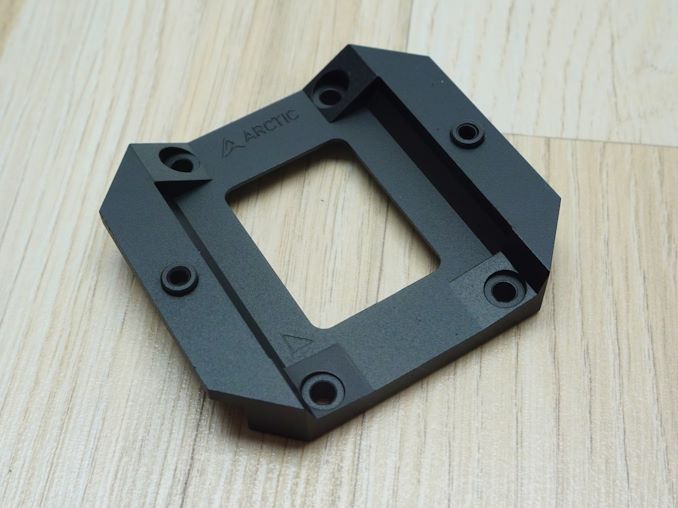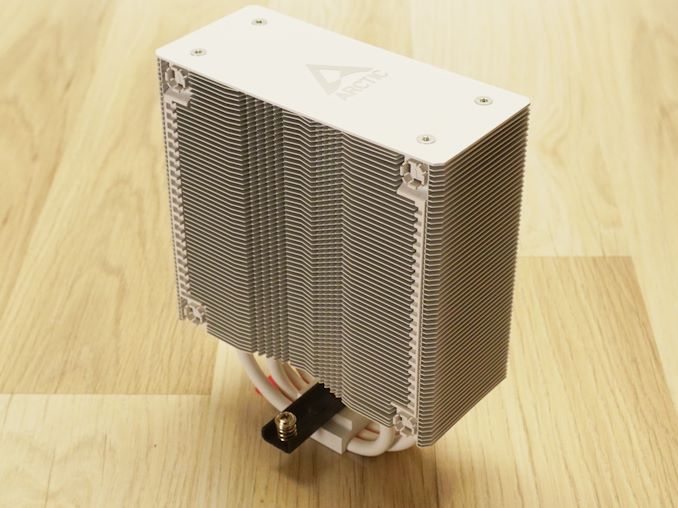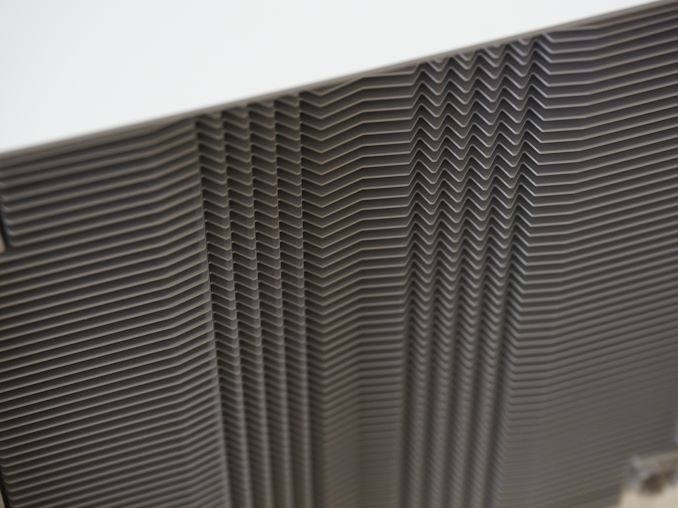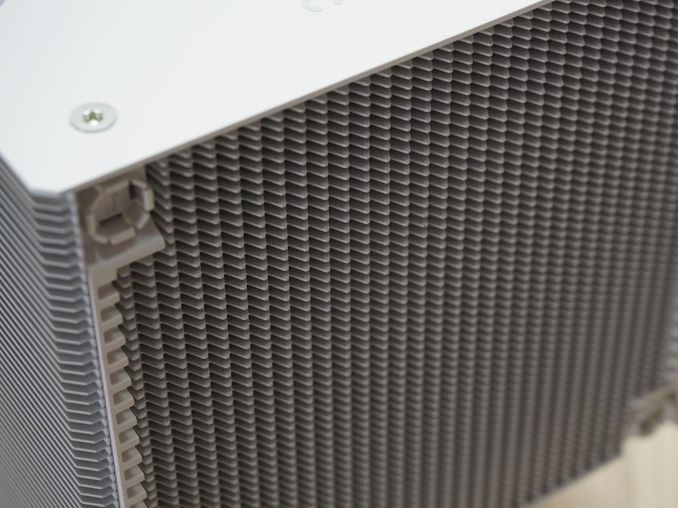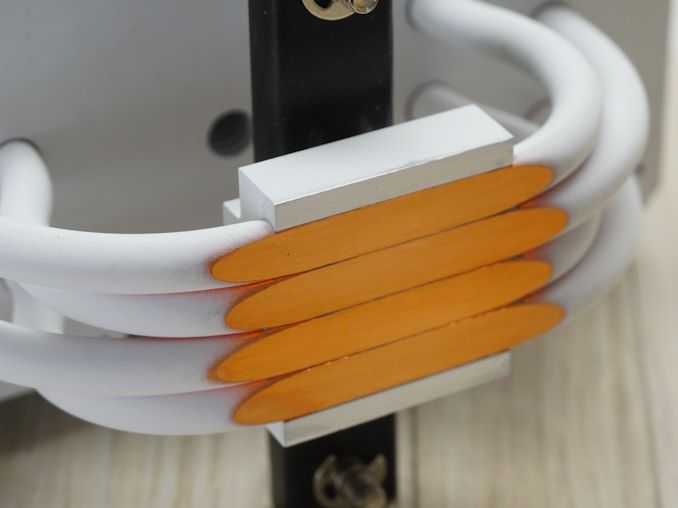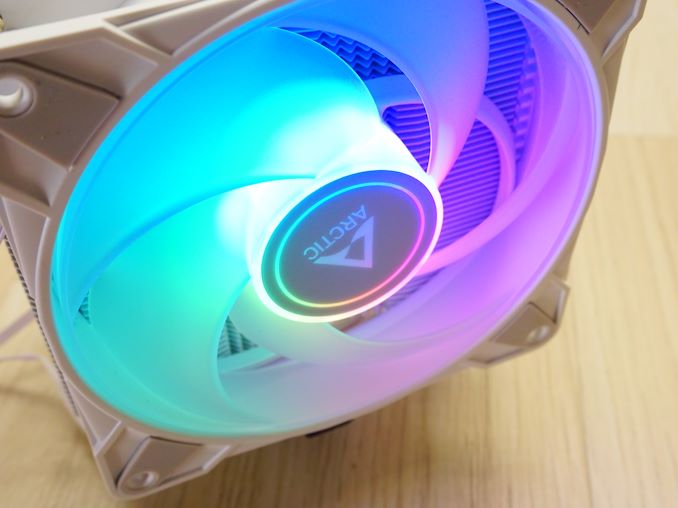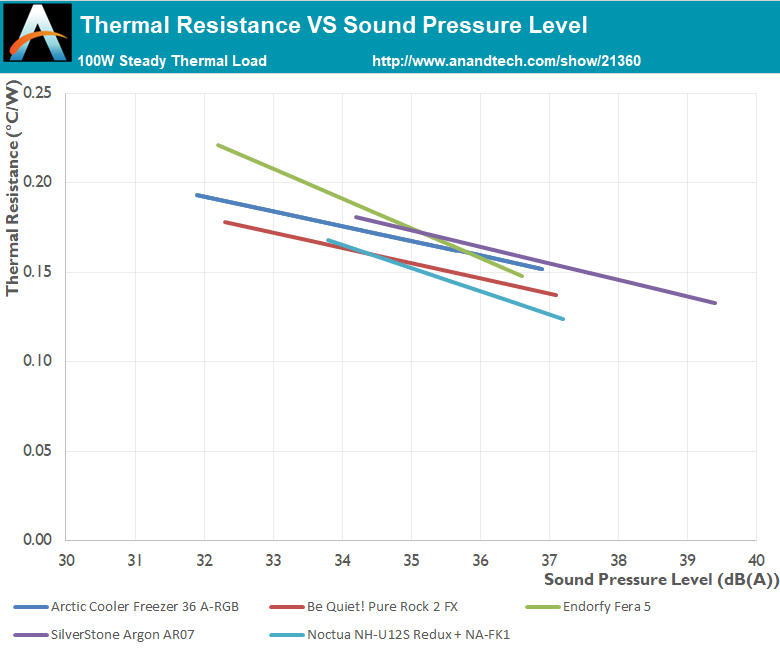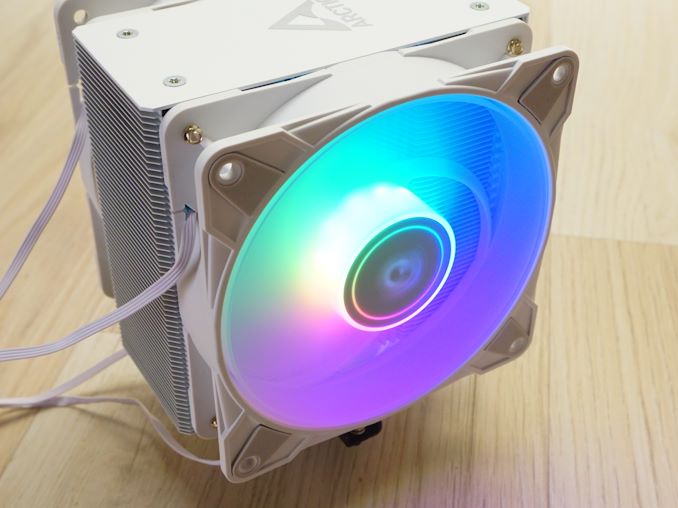
Original Link: https://www.anandtech.com/show/21360/the-arctic-cooling-freezer-36-argb-cpu-cooler-review
The Arctic Cooling Freezer 36 ARGB CPU Cooler Review: Budget Cooling Done Well
by E. Fylladitakis on May 16, 2024 9:00 AM EST- Posted in
- Cases/Cooling/PSUs
- Cooler
- Arctic
- CPU cooler
- ARGB
- Air Cooling
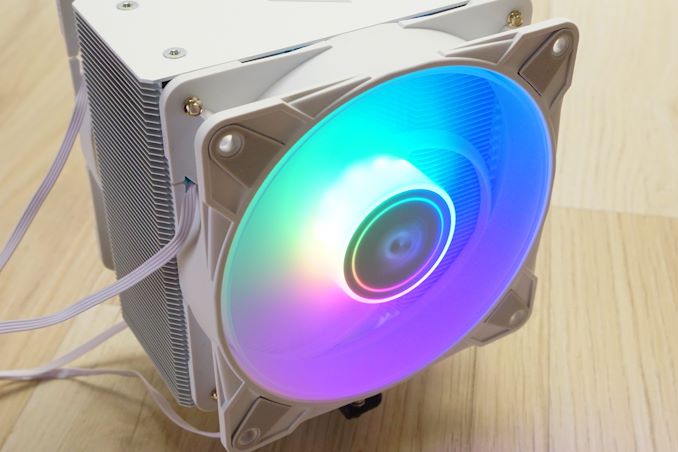
As modern high-performance CPUs generate more heat, there's been a noticeable increase in the demand for powerful air coolers capable of managing these thermal challenges. Traditional stock air coolers, while sufficient for regular use, are typically designed to be cheap and relatively compact, leaving further improvements to noise control and peak cooling efficiency on the table. This gap has long prompted advanced users and system builders to opt for high-quality aftermarket coolers that designed to better handle the heat output from top-tier processors.
Known for their innovative approach to PC hardware, Arctic Cooling has stepped into this competitive market with a product aimed at delivering effective cooling at a very low retail price. The Freezer 36 A-RGB, a dual fan tower cooler, is designed to support the cooling demands of the latest CPUs while also offering customizable RGB lighting for visual flair. This review will explore the features, performance, and value of the Arctic Cooling Freezer 36 A-RGB, comparing it with other leading products in the market to see how it stacks up in providing efficient and effective cooling for modern CPUs.
| Arctic Cooling Freezer 36 A-RGB CPU Cooler Specifications | |||
| Type | Tower Cooler | ||
| Dimensions | 104 x 126 x 159 mm | ||
| Fans | 2 x 120 mm P12 FDB Fan 2000 RPM (max) |
||
| RGB | Yes | ||
| Supported Sockets | Intel: LGA1700, LGA1851 AMD: AM5, AM4 |
||
| Warranty | 6 Years | ||
| Price | $44 (A-RGB) $33 (Non-RGB) |
||
Packaging & Bundle
Arctic Cooling packages the Freezer 36 A-RGB CPU Cooler in a clean, white cardboard box. The design of the box is straightforward, featuring a detailed schematic of the cooler on the front, highlighted with colored lettering to emphasize its RGB capabilities. The back of the box provides extensive information about the cooler's specifications and features.
The bundle of the Freezer 36 A-RGB CPU Cooler is very small compared to that of other coolers, and the reasons is both the limited socket compatibility and the simplicity of its mounting system. The cooler can be used with AMD’s AM4 and AM5 sockets, as well as Intel’s LGA1700 (with Arctic Cooling further promising LGA1851 once those platforms launch). Arctic supplies a special contact frame for Intel’s sockets that allegedly reduces the mechanical stress on the motherboard and improves contact with the processor. The company also supplies a syringe with one of their best thermal compounds, the MX-6, as well as a round sticker with the company logo.
The Arctic Cooling Freezer 36 A-RGB CPU Cooler
The Arctic Cooling Freezer 36 A-RGB CPU Cooler presents itself as a streamlined addition to the single-tower CPU cooler market. It is equipped with four heatpipes to conduct heat away from the CPU to the fin array. This cooler stands at 159 mm in height, making it suitable for a variety of system cases, including some compact options. Despite its capabilities, it maintains a lightweight profile at just 920 grams, which simplifies installation and reduces stress on the motherboard. The size and design ensure compatibility with adjacent components like RAM modules. Additionally, it sports an immaculate white paint finish that emanates an aura of quality.
The cooler features a unique asymmetric fin design that optimizes thermal efficiency and airflow. One side of the cooler showcases a partially sawtooth pattern, while the other side displays a full sawtooth pattern, supposedly aiding in cooling performance but also contributing to noise reduction by minimizing airflow turbulence. An elegant aluminum plate covers the top of the cooler, providing a sleek finish. This plate is adorned with a nickel-plated company logo, adding a subtle yet premium aesthetic touch to the cooler's appearance.
The Freezer 36 A-RGB has the simplest and most straightforward fan mounting mechanism that we have seen to this date. Plastic pockets are installed on the tower’s edges that are perfect fits for the button screws already preinstalled on the two supplied fans. Users need only push the fan onto the cooler slightly and it locks into place. There is no way to adjust the height of the fan like this but the assembly is not large enough to obstruct any RAM modules.
The base of the Freezer 36 A-RGB is very small, forming a contact surface that is just about 30 × 28 mm. The heatpipes come in direct contact with the CPUs IHS, with the aluminum block being there just to provide mechanical support.
The Arctic Cooling Freezer 36 A-RGB CPU Cooler comes equipped with two P12 PST 120mm fans, notable for their fluid dynamic bearing motors which ensure a balance of quiet operation and long-lasting performance. They are high pressure designs, with a handful of very wide blades. These fans feature impressively integrated RGB lighting, adding a dynamic visual element to the cooler. With a maximum speed of 2000 RPM and a full PWM range that allows speed adjustments from 0 to 2000 RPM, these fans offer exceptional flexibility to users.
Testing Methodology
Although the testing of a cooler appears to be a simple task, that could not be much further from the truth. Proper thermal testing cannot be performed with a cooler mounted on a single chip, for multiple reasons. Some of these reasons include the instability of the thermal load and the inability to fully control and or monitor it, as well as the inaccuracy of the chip-integrated sensors. It is also impossible to compare results taken on different chips, let alone entirely different systems, which is a great problem when testing computer coolers, as the hardware changes every several months. Finally, testing a cooler on a typical system prevents the tester from assessing the most vital characteristic of a cooler, its absolute thermal resistance.
The absolute thermal resistance defines the absolute performance of a heatsink by indicating the temperature rise per unit of power, in our case in degrees Celsius per Watt (°C/W). In layman's terms, if the thermal resistance of a heatsink is known, the user can assess the highest possible temperature rise of a chip over ambient by simply multiplying the maximum thermal design power (TDP) rating of the chip with it. Extracting the absolute thermal resistance of a cooler however is no simple task, as the load has to be perfectly even, steady and variable, as the thermal resistance also varies depending on the magnitude of the thermal load. Therefore, even if it would be possible to assess the thermal resistance of a cooler while it is mounted on a working chip, it would not suffice, as a large change of the thermal load can yield much different results.

Appropriate thermal testing requires the creation of a proper testing station and the use of laboratory-grade equipment. Therefore, we created a thermal testing platform with a fully controllable thermal energy source that may be used to test any kind of cooler, regardless of its design and or compatibility. The thermal cartridge inside the core of our testing station can have its power adjusted between 60 W and 340 W, in 2 W increments (and it never throttles). Furthermore, monitoring and logging of the testing process via software minimizes the possibility of human errors during testing. A multifunction data acquisition module (DAQ) is responsible for the automatic or the manual control of the testing equipment, the acquisition of the ambient and the in-core temperatures via PT100 sensors, the logging of the test results and the mathematical extraction of performance figures.
Finally, as noise measurements are a bit tricky, their measurement is being performed manually. Fans can have significant variations in speed from their rated values, thus their actual speed during the thermal testing is being recorded via a laser tachometer. The fans (and pumps, when applicable) are being powered via an adjustable, fanless desktop DC power supply and noise measurements are being taken 1 meter away from the cooler, in a straight line ahead from its fan engine. At this point we should also note that the Decibel scale is logarithmic, which means that roughly every 3 dB(A) the sound pressure doubles. Therefore, the difference of sound pressure between 30 dB(A) and 60 dB(A) is not "twice as much" but nearly a thousand times greater. The table below should help you cross-reference our test results with real-life situations.
The noise floor of our recording equipment is 30.2-30.4 dB(A), which represents a medium-sized room without any active noise sources. All of our acoustic testing takes place during night hours, minimizing the possibility of external disruptions.
| <35dB(A) | Virtually inaudible |
| 35-38dB(A) | Very quiet (whisper-slight humming) |
| 38-40dB(A) | Quiet (relatively comfortable - humming) |
| 40-44dB(A) | Normal (humming noise, above comfortable for a large % of users) |
| 44-47dB(A)* | Loud* (strong aerodynamic noise) |
| 47-50dB(A) | Very loud (strong whining noise) |
| 50-54dB(A) | Extremely loud (painfully distracting for the vast majority of users) |
| >54dB(A) | Intolerable for home/office use, special applications only. |
*noise levels above this are not suggested for daily use
Testing Results, Maximum Fan Speed
First, we are evaluating the Arctic Cooling Freezer 36 A-RGB with its included 120mm fans. While the maximum fan speed measured at 1910 RPM is slightly below the rated 2000 RPM, the consistent speed of the fans suggests good quality control.
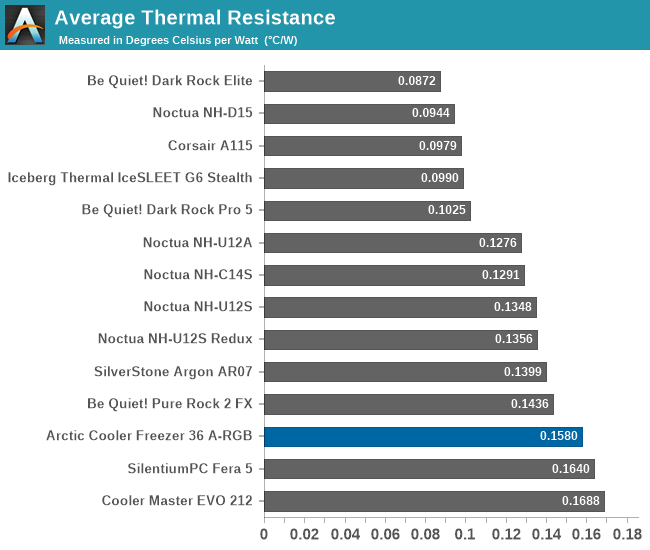
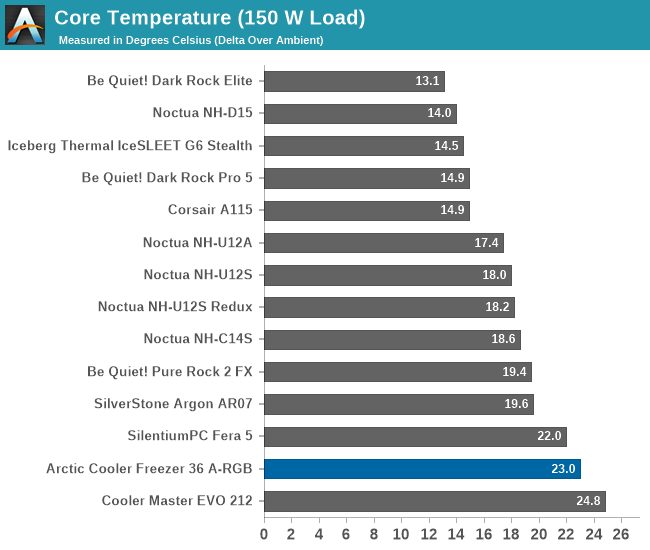
| Core Temperature, Constant Thermal Load (Max Fan Speed) |
The Arctic Cooling Freezer 36 A-RGB performs commendably for its size, aligning closely with the performance of other coolers in its class. It maintains an average thermal resistance of 0.158 °C/W at maximum fan speed, which is adequate for general high-load applications. However, it may not be the ideal choice for overclockers, especially those using CPUs with very high power consumption, as its performance under extremely heavy loads does not meet the more stringent cooling requirements demanded by such scenarios.
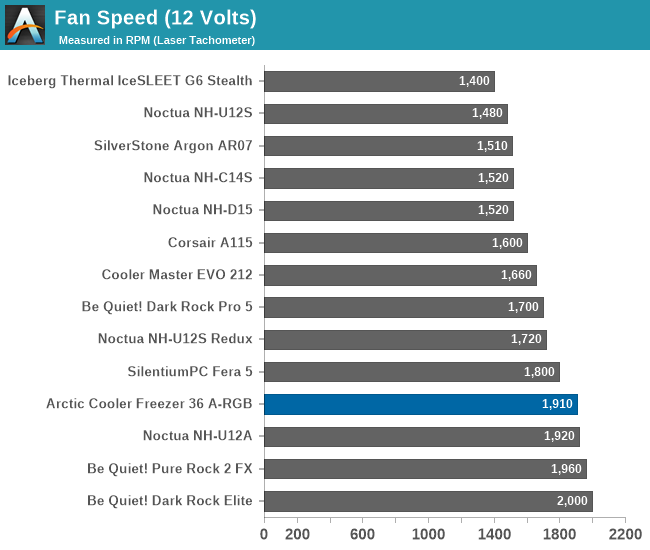
The Arctic Cooling Freezer 36 A-RGB is designed to manage noise efficiently. With minimal turbulence noise, it indicates a design optimized for low airflow resistance – which makes the selection for two high pressure fans a very peculiar design choice. At full speed, the noise level is recorded at 36.9 dB(A), which is quite reasonable, particularly given the cooler's dual 120 mm fan configuration. This noise level, while not the lowest on the market, offers a fair balance between effective cooling and noise reduction.

Testing Results, Low Fan Speed
In this test we are adjusting our approach by examining how the Arctic Cooling Freezer 36 A-RGB performs with its fans operating at half speed. This change allows us to assess the cooler's efficiency under reduced airflow conditions.
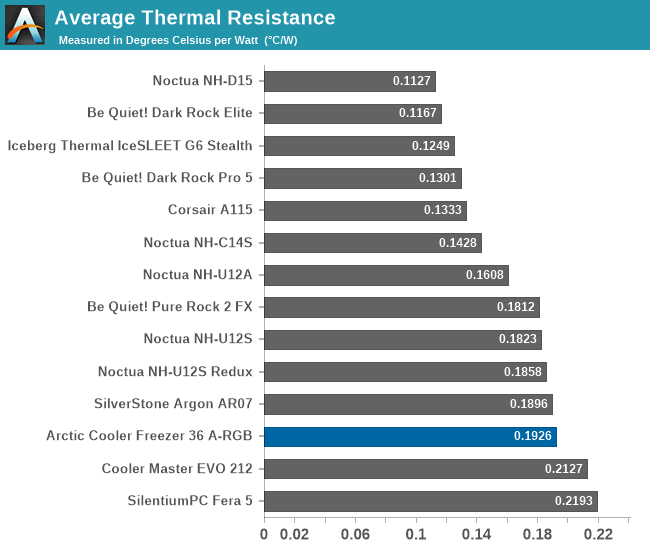
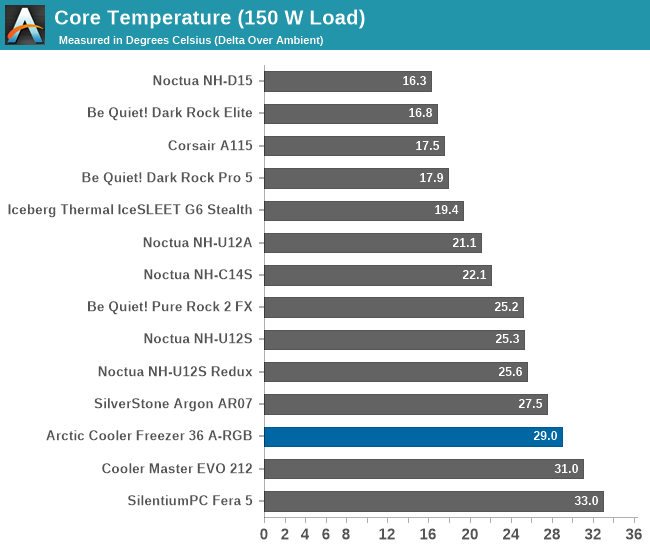
| Core Temperature, Constant Thermal Load (Low Fan Speed) |
Reducing the fan speed on the Arctic Cooling Freezer 36 A-RGB to half, approximately 990 RPM, results in a moderate increase in thermal resistance to 0.1926 °C/W. This adjustment aligns the cooler's performance closely with that of similar-sized competitors. While it maintains solid performance, it does not lead the pack in thermal efficiency at reduced fan speeds. The cooler continues to perform well, but it is important to consider both thermal and acoustic performance under these adjusted conditions.
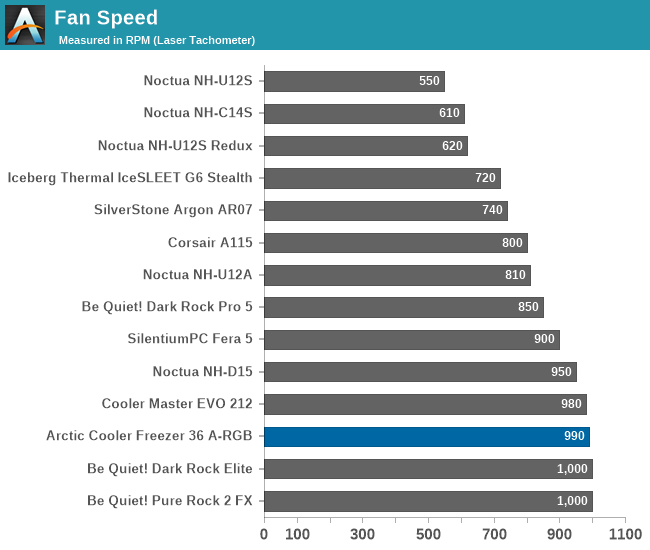
At the reduced fan speed of 990 RPM, the noise level of the Arctic Cooling Freezer 36 A-RGB drops to 31.9 dB(A). This level is very quiet, making the cooler barely noticeable in typical home office environments. Under these conditions, it becomes virtually undetectable except in extremely quiet settings devoid of other noise sources. However, this kind of acoustic performance is fairly common among competitors of similar size and design.

Thermal Resistance VS Sound Pressure Level
During our thermal resistance vs. sound pressure level test, we maintain a steady 100W thermal load and assess the overall performance of the coolers by taking multiple temperature and sound pressure level readings within the operating range of the stock cooling fans. The result is a graph that depicts the absolute thermal resistance of the cooler in comparison to the noise generated. For both the sound pressure level and absolute thermal resistance readings, lower figures are better.
The above chart reveals that the Arctic Cooling Freezer 36 A-RGB falls toward the quiet part of the performance spectrum. It exhibits great low-noise performance but increasing the speed of the fans does not yield significantly better results. This may be due to the use of high-pressure fans, which cannot reach very high airflow figures compared to other designs. Nevertheless, the cooler is close to much more expensive single-tower coolers and outperforms popular designs at low fan speeds.
Conclusion
The Arctic Cooling Freezer 36 A-RGB is a commendable cooler, especially when considering its modest design. The build quality is solid, reflecting Arctic Cooling's focus on functional and durable products. However, the real standout feature of this cooler is its affordability – so much so that in recent weeks we've seen price increases at multiple retailers after the cooler has been repeatedly out of stock. At the moment, you can find the the white ARGB version for just $44, while the even cheaper non-RGB model runs for $33, making the two models a significant value even in the highly-competitive cooler market.
The Freezer 36's construction is straightforward yet effective, utilizing durable materials and a design that prioritizes ease of installation and maintenance. While it might not deliver the top-tier performance of more expensive units, particularly under extreme loads, it holds its own in everyday usage scenarios, providing a good balance of cooling efficiency and noise control. The noise level is manageable, making the Freezer 36 suitable for home office environments where low noise is appreciated. While it may not outperform all competitors in noise-to-performance ratio, its affordability makes it a very attractive option for budget-conscious consumers.
Performance-wise, the Freezer 36 A-RGB is equipped with four heatpipes and an asymmetric fin design that optimizes airflow and enhances cooling efficiency. The unique fin patterns - a partially sawtooth on one side and a full sawtooth on the other - help to reduce airflow turbulence, thereby minimizing noise while maximizing heat dissipation. The full PWM control allows users to tailor fan speeds according to their needs, balancing performance and noise based on their specific usage scenarios. Its overall performance does not turn heads but it is passable for a mid-range product designed for casual users and system builders.
Overall, the Arctic Cooling Freezer 36 A-RGB provides a compelling blend of aesthetics and performance. Its sleek design and RGB lighting enhance the visual appeal of any system, while its solid cooling capabilities make it a practical choice for a wide range of CPU cooling needs. Given its highly affordable price point, it presents an excellent value for both novice builders and seasoned enthusiasts looking for effective cooling solutions for stock-running processors or energy-efficient processors without breaking the bank.



